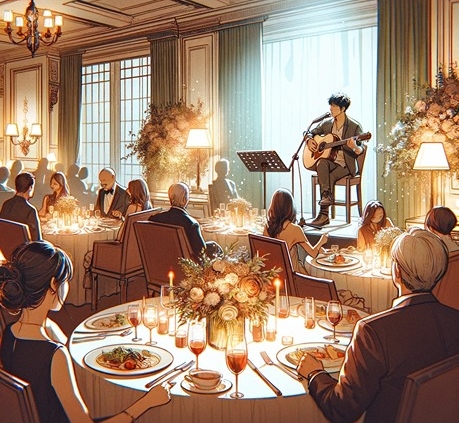Intimate Dinner Concerts: Elevating Dining with Solo Performances
/in Blog Posts/by denniswingeAn intimate dinner concert combines the sensory pleasures of gourmet dining with the soul-stirring beauty of live music, creating an unforgettable experience for guests. This unique fusion offers a way to elevate a standard dining event into something truly special, where a solo instrumentalist or vocalist provides the perfect background ambiance. This blog post explores how to create a memorable dining experience by incorporating solo performances into the mix.
The performance can either be with vocals, as in this solo acoustic performance at a winery, or it can be instrumental, like this solo instrumental performance at a wedding reception. Here are some things to consider when planning such an event.
Selecting the Right Musician
The choice of musician is pivotal in setting the tone for the evening. Whether it’s a classical guitarist, a jazz pianist, a violinist, or a soulful vocalist, the performer should complement the theme of the dinner and resonate with the audience. Consider the acoustics of the venue and the musical preferences of your guests when making your selection. The right musician can set the mood and enhance the overall dining experience, making it memorable for all attendees.
The performance can either be with vocals as in this solo acoustic performance at a winery or it can be instrumental, like this solo instrumental performance at a wedding reception. Here are some things to consider when planning such an event.
Tips for Choosing the Perfect Performer:
- Match the Music to the Theme: Choose a musician whose style aligns with the event’s theme. For example, a classical guitarist might be perfect for an elegant, formal dinner, while a jazz pianist could set a relaxed, sophisticated mood.
- Consider Acoustics: Ensure the musician can perform comfortably in the chosen venue without overpowering the conversation. Acoustic instruments or lightly amplified setups are often best for intimate settings.
- Audience Preferences: Take into account the musical tastes of your guests. A mix of familiar favorites and unique pieces can keep the audience engaged and entertained.
 Creating the Perfect Atmosphere
Creating the Perfect Atmosphere
Venue Selection
Choose a venue that enhances the intimacy of the event—think cozy restaurants, private dining rooms, or even a transformed space in a home. The setting should be conducive to both dining and listening, allowing guests to enjoy the music without it overpowering conversation.
Seating Arrangement
Arrange seating in a way that every guest has a clear view of the performer, fostering a connection between the artist and the audience. Round tables can encourage conversation while still focusing attention on the performance. Consider placing the musician in a central or slightly elevated position to ensure visibility and audibility.
Lighting and Decor
Soft, ambient lighting and elegant decor can complement the music and enhance the dining experience. Candles, fairy lights, or dimmable overhead lights can create a warm and inviting atmosphere. Choose decor elements that reflect the theme of the event and create a cohesive, visually appealing environment.
Acoustic Considerations
Ensure the music enriches the dining experience without overwhelming it. The volume should be balanced so that it envelops the space pleasantly, allowing for easy conversation. Work with the musician to set up the best sound system for the venue to achieve the perfect acoustic balance.
Curating the Menu
The menu should be as thoughtfully curated as the music, with dishes that reflect the sophistication of the event. Pairing courses with the music can add an element of surprise and delight—for instance, serving a light, airy dessert during a particularly ethereal piano piece. Consider the following:
- Complementary Courses: Design a menu that complements the music. Light, refreshing courses can pair well with soft, melodic pieces, while richer, more robust dishes might be suited to more dramatic musical selections.
- Wine Pairings: Enhance the dining experience with carefully selected wines that match each course and the overall theme of the event.
- Seasonal Ingredients: Use fresh, seasonal ingredients to create dishes that are both delicious and reflective of the time of year.
Engaging the Audience
While the focus is on the music and dining, adding interactive elements can enhance the experience. This could be a brief introduction to each musical piece, a moment where the musician shares insights into their art, or even a request segment where guests can ask for their favorite tunes. Interaction can make the evening more personal and memorable for guests.
guests.
Interactive Elements to Consider:
- Musician Introductions: Have the musician introduce themselves and their pieces, sharing stories or insights that add depth to the performance.
- Audience Requests: Allow guests to request songs or dedicate pieces to fellow attendees, creating a more personalized experience.
- Q&A Sessions: Offer a brief Q&A session where guests can learn more about the musician’s background and inspirations.
Conclusion
Intimate dinner concerts offer a unique way to celebrate special occasions, impress clients, or simply elevate a gathering of friends and family. By carefully selecting the musician, crafting the atmosphere, and pairing exquisite dishes with captivating performances, hosts can create an evening that guests will cherish long after the last note has faded. This blend of culinary excellence and musical artistry promises not just a meal, but a truly sensory journey.
—
If you want live music for your next event, book a free music consultation with me or reach out via the contact page for more information.



